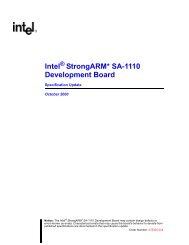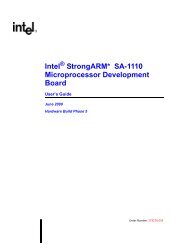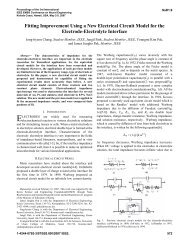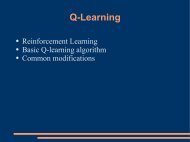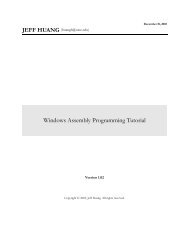Beej's Guide to Network Programming Using Internet Sockets
Beej's Guide to Network Programming Using Internet Sockets
Beej's Guide to Network Programming Using Internet Sockets
- No tags were found...
You also want an ePaper? Increase the reach of your titles
YUMPU automatically turns print PDFs into web optimized ePapers that Google loves.
Beej’s <strong>Guide</strong> <strong>to</strong> <strong>Network</strong> <strong>Programming</strong> <strong>Using</strong> <strong>Internet</strong> <strong>Sockets</strong> 628.16. select()Check if sockets descrip<strong>to</strong>rs are ready <strong>to</strong> read/writePro<strong>to</strong>types#include int select(int n, fd_set *readfds, fd_set *writefds,fd_set *exceptfds, struct timeval *timeout);FD_SET(int fd, fd_set *set);FD_CLR(int fd, fd_set *set);FD_ISSET(int fd, fd_set *set);FD_ZERO(fd_set *set);DescriptionThe select() function gives you a way <strong>to</strong> simultaneously check multiple sockets <strong>to</strong> see ifthey have data waiting <strong>to</strong> be recv()d, or if you can send() data <strong>to</strong> them without blocking, or ifsome exception has occurred.You populate your sets of socket descrip<strong>to</strong>rs using the macros, like FD_SET(), above. Onceyou have the set, you pass it in<strong>to</strong> the function as one of the following parameters: readfds if youwant <strong>to</strong> know when any of the sockets in the set is ready <strong>to</strong> recv() data, writefds if any of thesockets is ready <strong>to</strong> send() data <strong>to</strong>, and/or exceptfds if you need <strong>to</strong> know when an exception(error) occurs on any of the sockets. Any or all of these parameters can be NULL if you’re notinterested in those types of events. After select() returns, the values in the sets will be changed<strong>to</strong> show which are ready for reading or writing, and which have exceptions.The first parameter, n is the highest-numbered socket descrip<strong>to</strong>r (they’re just ints, remember?)plus one.Lastly, the struct timeval, timeout, at the end–this lets you tell select() how long <strong>to</strong>check these sets for. It’ll return after the timeout, or when an event occurs, whichever is first. Thestruct timeval has two fields: tv_sec is the number of seconds, <strong>to</strong> which is added tv_usec,the number of microseconds (1,000,000 microseconds in a second.)The helper macros do the following:FD_SET(int fd, fd_set *set);FD_CLR(int fd, fd_set *set);FD_ISSET(int fd, fd_set *set);FD_ZERO(fd_set *set);Add fd <strong>to</strong> the set.Remove fd from the set.Return true if fd is in the set.Clear all entries from the set.





